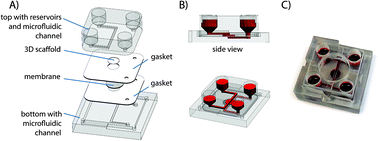Multi-cellular 3D human primary liver cell culture elevates metabolic activity under fluidic flow
Abstract
We have developed a low-cost liver cell culture device that creates fluidic flow over a 3D primary liver cell culture that consists of multiple liver cell types, including hepatocytes and non-parenchymal cells (fibroblasts, stellate cells, and Kupffer cells). We tested the performance of the cell culture under fluidic flow for 14 days, finding that hepatocytes produced albumin and urea at elevated levels compared to static cultures. Hepatocytes also responded with induction of P450 (CYP1A1 and CYP3A4) enzyme activity when challenged with P450 inducers, although we did not find significant differences between static and fluidic cultures. Non-parenchymal cells were similarly responsive, producing interleukin 8 (IL-8) when challenged with 10 μM bacterial lipoprotein (LPS). To create the fluidic flow in an inexpensive manner, we used a rocking platform that tilts the cell culture devices at angles between ±12°, resulting in a periodically changing hydrostatic pressure drop between reservoirs and the accompanying periodically changing fluidic flow (average flow rate of 650 μL min−1, and a maximum shear stress of 0.64 dyne cm−2). The increase in metabolic activity is consistent with the hypothesis that, similar to unidirectional fluidic flow, primary liver cell cultures increase their metabolic activity in response to fluidic flow periodically changes direction. Since fluidic flow that changes direction periodically drastically changes the behavior of other cells types that are shear sensitive, our findings support the theory that the increase in hepatic metabolic activity associated with fluidic flow is either activated by mechanisms other than shear sensing (for example increased opportunities for gas and metabolite exchange), or that it follows a shear sensing mechanism that does not depend on the direction of shear. Our mode of device operation allows us to evaluate drugs under fluidic cell culture conditions and at low device manufacturing and operation costs.


 Please wait while we load your content...
Please wait while we load your content...